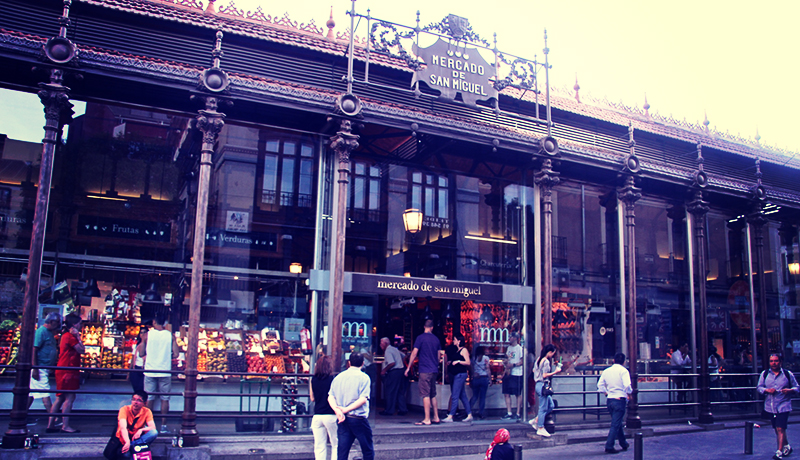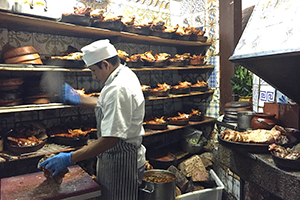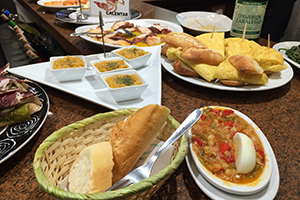
Over the past couple of years, Spanish culinary culture has been on the rise in the United States. This past winter, Forbes even predicted that 2015 would be the year Spanish cuisine would start to overshadow those of Asia and France. Spanish-born José Andrés was one of the first chefs to introduce Americans to the concept of tapas, and newer generations of gastro geniuses continue to educate U.S. diners on the depth and diversity of Spanish cuisine.
Jamie Bissonnette and Ken Oringer have gained immense popularity for their traditional and modern tapas and paella at Toro in New York’s Meatpacking District. Wine and spirits aficionado Derek Brown educates D.C. diners on sherry with tastings, cocktails and pairings at Mockingbird Hill, and Austin restaurateur Shawn Cirkiel is gearing up to open the much-anticipated tapas restaurant Bullfight late this summer.
But to truly experience Spanish cuisine, there is no substitute for visiting the vast, beautiful country itself. Here are three adventures every epicurean should add to his bucket list.
Old Madrid
What to do
Of late, Spain has made headlines because of inventive chefs like Ferran Adrià, who continues to revolutionize New Spanish cuisine, as he prepares to open elBullifoundation and Heart Ibiza. But, when in Spain, it’s important to honor tradition and seek out the roots that laid the very framework for modern Spanish cuisine. And where better to start than the world’s oldest recorded restaurant? Madrid’s Restaurante Botín is known for its suckling pigs and lambs roasted in the same wood-fired Castilian oven it’s been using since opening in 1725.
Botín is located in the city’s center, just a couple blocks from Plaza Mayor, Madrid’s most well-known plaza and a must-see for all visitors. While there are a number of more touristic establishments in the area, there are also plenty of gems tucked into the smaller side streets surrounding the plaza, many housed in the capital city’s ornate 17th-century buildings. Cava Baja is a lively street filled with tapas bars and restaurants ranging from the historic Posada de la Villa to the modern Taberna la Concha, where gluten-free dishes are the norm.
Other tiny tapas bars specialize in particular dishes — Meson del Chimpiñón serves mushroom caps that are sprinkled with salt, parsley and Ibérico ham, then baked to succulence, while Meson de la Tortilla has perfected the art of the Spanish tortilla. Also be sure to try a bocadillo de calamares (calamari sandwich), a Madrid specialty found at area bars like La Campana and La Ideal.
Also in the neighborhood is Mercado de San Miguel, a foodie paradise inside a renovated historic marketplace. Much like New York’s Gotham West Market or Mexico City’s Mercado Roma, San Miguel is a maze of bars, shops and stalls specializing in everything from olives and cheese to paella. By 9 p.m., the market is typically filled with locals and tourists, socializing while sipping vermouth and sampling tapas from the kiosks. Follow suit, but save room for a nightcap of churros and rich drinking chocolate at the historic Chocolateria San Ginés.
Where to stay
In a 19th-century palace designed by the same architect responsible for Plaza Mayor, Juan de Villanueva, is the NH Palacio de Tepa Madrid Collection. The 85-room property features stunning design and spacious suites.
Jerez
What to do
Sherry hails from an area of southern Spain known as the Sherry Triangle, a shape formed by the Andalucían towns of Jerez de la Frontera, Sanlúcar de Barrameda and El Puerto de Santa María. The Gonzalez Byass family of wines has become known throughout Spain for its iconic Tio Pepe dry fino sherry, often enjoyed in refreshing rebujitos (drinks mixed with lemon juice, sugar and water, then served over ice).
But a visit to the sprawling winery in Jerez will reveals that Tio Pepe is just the beginning. Bodega Tio Pepe offers varying levels of experiences, ranging from tours of soleras (where visitors like Picasso and Jacques Cousteau have signed the aging barrels) to technical tastings led by winemakers and classes on pairing sherry with food. At neighboring La Carbona, chef Javier Muñoz (dubbed “The Sherry Chef”) proves that varieties like nutty amontillado and velvety Pedro Ximénez are just as good cooked into dishes as they are paired with them. His specialty is tuna, so be sure to order cold, unfiltered fino en rama to accompany the tartare with an oloroso emulsion and immaculate roasted tuna belly.
Southern Spain’s hot, arid weather allows sherry’s Palomino grapes to thrive in the sandy soil, so plan a visit to the area in April through June or September through October. (The sun can be quite the scorcher in July and August, and it doesn’t make its way below the horizon until after 10 p.m.) Take respite from the heat at the nearby beaches of El Puerto de Santa María along the Bay of Cadiz. Visit the Feria de Jerez extravaganza in May; the Jerez fairgrounds come alive with parades of horse-drawn carriages, casetas showcasing flamenco performers, dancing Sevillanas and, of course, lots of sherry.
Where to stay
If you’re planning on visiting during Feria, you can’t get any closer to the action than by staying at Hotel Jerez & Spa, whose sleek and simple rooms feature direct access to a spacious heated swimming pool.
San Sebastián
What to do
San Sebastián, a coastal city in Spain’s northern Basque country, is considered by many to be the country’s culinary epicenter. Situated just 12 miles from the French border, San Sebastián has one of the highest concentrations of award-winning chefs per square mile in the world. And while globally acclaimed restaurants such as Arzak, Mugaritz and Akelaŕe are major draws, so is the vibrantly unique Basque pintxo culture. Pintxos are similar to tapas, but served exclusively in single, bite-sized portions, often skewered or placed on a piece of bread. Most pintxo bars are open all day but, between about 8 p.m. and midnight, they swell to standing room only, as people socialize while sipping on txakoli (a slightly sparking, dry Basque white wine) and snack. It’s also not uncommon to see groups of friends (often older men) break out into jovial song together.
With more than 200 pintxo bars across the city, it is wise to sign up for a tour with one of San Sebastián Food’s knowledgeable guides. The culinary company and gourmet shop is located inside the beautiful Hotel Maria Cristina, and it recently opened up a cooking school downstairs for those who want to take their pintxo knowledge to the next level. The majority of San Sebastián’s bars are located along the cobblestone streets in Old Town (Parte Vieja). Bar La Cepa, founded in 1948, is one of the more historic pintxo bars, and its bocadillos de jamón (ham sandwiches) are a thing of beauty. Next door is La Viña, another classic spot made famous for its heavenly burnt Basque cheesecake. Restaurante Gandarias serves flawless grilled squid drizzled with squid ink and the thinnest Joselito Ibérico ham in town.
Plenty of modern pintxo bars are making their mark in San Sebastián as well. Though Bar Zeruko has been a family business for 35 years, their son recently took over the kitchen and has been creating gastro-molecular works of art, like tableside smoked bacalao (cod) accompanied by parsley “roe” and liquid lettuce. The hip A Fuego Negro also offers its own avant-garde interpretations of Basque dishes. The bar’s relaxed vibe and great soundtrack will have you sticking around for drinks long after the last pintxo has been devoured.
Where to stay
San Sebastián’s historic boutique Hotel de Londres y de Inglaterra looks out onto the picturesque Playa La Concha while its interior exudes beachside tranquility crossed with Belle Epoque charm.



